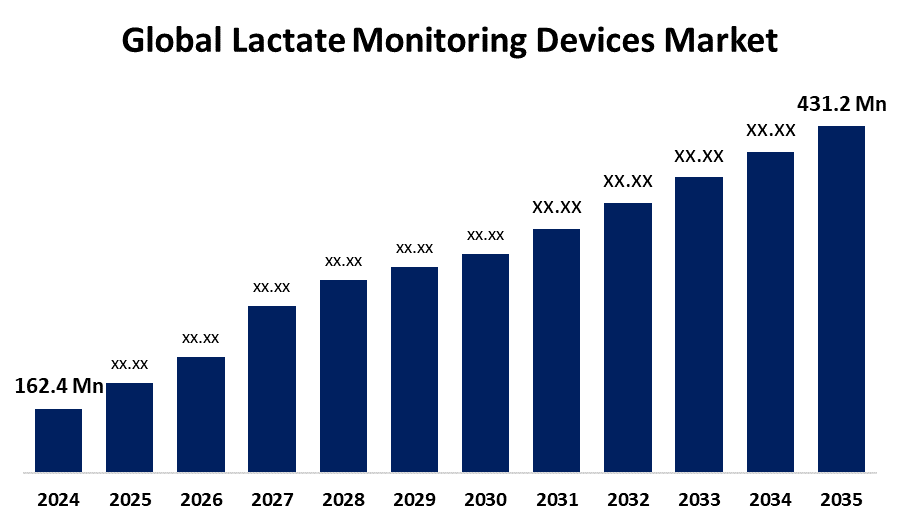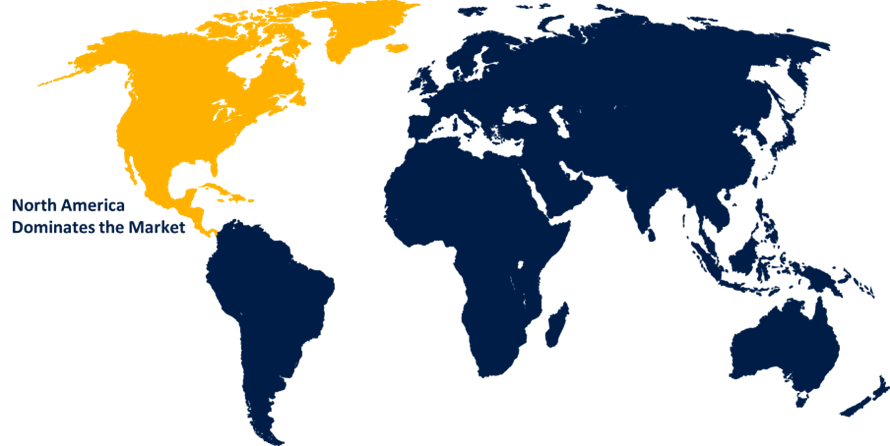Global Lactate Monitoring Devices Market Size, Share, and COVID-19 Impact Analysis, By Product (Chargeable Lactate Meters and Battery-Operated Lactate Meters), By Application (Sports, Medical, and Others), and By Region (North America, Europe, Asia-Pacific, Latin America, Middle East, and Africa), Analysis and Forecast 2025 - 2035
Industry: HealthcareGlobal Lactate Monitoring Devices Market Insights Forecasts to 2035
- The Global Lactate Monitoring Devices Market Size Was Estimated at USD 162.4 Million in 2024
- The Market Size is Expected to Grow at a CAGR of around 9.28% from 2025 to 2035
- The Worldwide Lactate Monitoring Devices Market Size is Expected to Reach USD 431.2 Million by 2035
- Asia Pacific is Expected to Grow the fastest during the forecast period.

Get more details on this report -
According to a research report published by Spherical Insights & Consulting, The Global Lactate Monitoring Devices Market Size was worth around USD 162.4 Million in 2024 and is predicted to grow to around USD 431.2 Million by 2035 with a compound annual growth rate (CAGR) of 9.28% from 2025 and 2035. The need for point-of-care diagnostics is growing, telemedicine and remote patient monitoring are becoming more popular, and people are becoming more aware of the advantages of lactate monitoring in sports and healthcare.
Market Overview
The lactate monitoring devices market includes equipment for measuring lactate levels in blood, which aids in the evaluation of physical performance and medical issues. These gadgets are commonly used in sports, critical care, and diagnostics. An increasingly older population, higher usage of home-based healthcare, and expanded use in surgery and post-operative care are all driving growth in the market for lactate monitoring devices. Lactate monitoring is an early indicator of tissue hypoperfusion; it is essential for the management of critically ill patients, especially in situations of sepsis, trauma, and organ malfunction. It enhances the results of complex procedures, trauma, and cardiac arrest and enables prompt therapeutic interventions. A 2025 study promoted improved graft quality assessment by highlighting lactate as a real-time indicator in liver transplants. This method promotes the wider use of lactate monitoring in transplant centres to enhance organ utilisation and patient outcomes by providing a repeatable and affordable substitute for intricate biomarker testing.
Wearable technology and point-of-care devices are advancing technology innovations to allow for real-time, user-friendly monitoring. For instance, in 2023, Tokyo University of Science developed a wearable sweat lactate sensor; using lactate monitoring greatly aids elite athletes, since lactate concentration is imperative for determining anaerobic thresholds, which is important for more effective training. The FDA and other regulators dictate the accuracy and safety of devices. Participants in the market are also expanding their geographical reach to provide access to emerging markets, which has allowed for the continual advancement of lactate monitoring technologies and their use for varied applications across the globe.
Report Coverage
This research report categorizes the lactate monitoring devices market based on various segments and regions, forecasts revenue growth, and analyzes trends in each submarket. The report analyses the key growth drivers, opportunities, and challenges influencing the lactate monitoring devices market. Recent market developments and competitive strategies such as expansion, type launch, development, partnership, merger, and acquisition have been included to draw the competitive landscape in the market. The report strategically identifies and profiles the key market players and analyses their core competencies in each sub-segment of the lactate monitoring devices market.
Driving Factors
The growing incidence of chronic illnesses, including diabetes and heart disorders, as well as the growing need for precise, real-time monitoring solutions, are driving the lactate monitoring device market. Adoption is increased by the move towards home-based care and personalised treatment, and usability and dependability are improved by technology developments in sensors, wireless connectivity, and data analytics. Furthermore, the market is rising outside of clinical settings into sports and fitness applications as a result of athletes' increased knowledge of lactate's significance in performance optimisation.
Restraining Factors
The lactate monitoring devices market is limited by the high cost of devices, lack of reimbursement, and need for regular calibration. Accuracy errors with non-invasive sensors are often compounded by variability due to individual and environmental factors. Meanwhile, regulatory challenges, professional handling requirements, and a lack of standardisation also limit the integration of widespread uptake and implementation, specifically in non-clinical settings and the sports and fitness market, which limits market growth.
Market Segmentation
The lactate monitoring devices market share is classified into product and application.
- The battery-operated lactate meters segment dominated the market in 2024 and is projected to grow at a substantial CAGR during the forecast period.
Based on the product, the lactate monitoring devices market is divided into chargeable lactate meters and battery-operated lactate meters. Among these, the battery-operated lactate meters segment dominated the market in 2024 and is projected to grow at a substantial CAGR during the forecast period. Its versatility and ease of use in a range of environments, such as clinics, hospitals, and sports fields, are responsible for its expansion. Because battery-operated lactate meters are portable and don't need a direct power source, athletes, coaches, and medical professionals can conduct lactate testing while on the go without being constrained by power outlets. Additionally, battery-operated lactate meters frequently yield findings quickly, enabling prompt decision-making in situations involving patient care or sports training.
- The sports segment accounted for the largest share in 2024 and is anticipated to grow at a significant CAGR during the forecast period.
Based on the application, the lactate monitoring devices market is divided into sports, medical, and others. Among these, the sports segment accounted for the largest share in 2024 and is anticipated to grow at a significant CAGR during the forecast period. The growing desire to customise training plans and enhance athletic performance is driving the market's expansion. Running, swimming, and cycling are among the sports that benefit from the real-time data that lactate monitoring devices provide on an athlete's metabolic state during exercise. These tools facilitate the development of training regimens that incorporate both speed and endurance exercises. Athletes can optimise their regimens for improved performance and quicker recovery by monitoring changes in their lactate threshold over time.
Regional Segment Analysis of the Lactate Monitoring Devices Market
- North America (U.S., Canada, Mexico)
- Europe (Germany, France, U.K., Italy, Spain, Rest of Europe)
- Asia-Pacific (China, Japan, India, Rest of APAC)
- South America (Brazil and the Rest of South America)
- The Middle East and Africa (UAE, South Africa, Rest of MEA)
North America is anticipated to hold the largest share of the lactate monitoring devices market over the predicted timeframe.

Get more details on this report -
North America is anticipated to hold the largest share of the lactate monitoring devices market over the predicted timeframe. North America's strong adoption of health technologies, investment in fitness, and sophisticated healthcare infrastructure are expected to propel the market for lactate monitoring devices. Complex treatments, particularly those needing lactate monitoring, are supported by the region's cutting-edge medical facilities. The need for wearable technology and health tracking solutions is increasing as fitness optimisation becomes popular. North America is a prominent force in this market due to its steady growth in the fitness technology sector and emphasis on cutting-edge medical solutions. This persistent pattern demonstrates the region's pivotal role in propelling the creation and broad implementation of cutting-edge lactate monitoring technology.
Asia Pacific is expected to grow at a rapid CAGR in the lactate monitoring devices market during the forecast period. The market for lactate monitoring devices is expanding rapidly as a result of increased surgical procedures, early sepsis intervention initiatives, and growing demand for critical care. The rise of the business is further supported by government measures to improve the infrastructure for trauma and critical care. A low-cost, minimally invasive continuous lactate monitoring system connected to a smartphone was created by Taiwanese researchers in 2022, with a focus on clinical and athletic uses. Rising sepsis rates, increased investment in critical care, and athletes' growing interest in wearable monitors are driving the market's expansion in India. Rapid adoption of lactate monitoring technology is also being fuelled by Japan's ageing population and the country's increasing rates of serious illnesses like heart failure and sepsis.
Competitive Analysis:
The report offers the appropriate analysis of the key organizations/companies involved within the lactate monitoring devices market, along with a comparative evaluation primarily based on their type of offering, business overviews, geographic presence, enterprise strategies, segment market share, and SWOT analysis. The report also provides an elaborative analysis focusing on the current news and developments of the companies, which includes type development, innovations, joint ventures, partnerships, mergers & acquisitions, strategic alliances, and others. This allows for the evaluation of the overall competition within the market.
List of Key Companies
- Nova Biomedical
- EKF Diagnostics
- TECOM Analytical Systems
- Sensa Core Medical
- VivaCheck Biotech
- ApexBio
- TaiDoc Technology Corporation
- Siemens Healthineers
- Lactate Plus
- Menarini Diagnostics
- Roche Diagnostics
- Draeger
- Medtronic
- Abbott Laboratories
- HemoCue
- ARKRAY
- Others
Key Target Audience
- Market Players
- Investors
- End-users
- Government Authorities
- Consulting And Research Firm
- Venture capitalists
- Value-Added Resellers (VARs)
Recent Development
- In March 2025, Advanced Instruments, a division of Patricia Industries, agreed to pay USD 2.2 billion to purchase Nova Biomedical. With operations in more than 100 countries, a strong product portfolio in the biopharma and clinical industries, and strong financials, the combined company will be known as Nova Biomedical. The founders of Nova will continue to serve as consultants to Byron Selman, who will head the new business.
- In January 2024, VivaChek released its most recent Lactate Analyser globally. Designed specifically for sportsmen, this gadget provides precise lactate measurements to improve training and recuperation plans. Real-time performance tracking and well-informed coaching decisions are made possible by its Bluetooth connection, which allows for easy data uploading to mobile devices.
Market Segment
This study forecasts revenue at global, regional, and country levels from 2020 to 2035. Spherical Insights has segmented the lactate monitoring devices market based on the below-mentioned segments:
Global Lactate Monitoring Devices Market, By Product
- Chargeable Lactate Meters
- Battery-Operated Lactate Meters
Global Lactate Monitoring Devices Market, By Application
- Sports
- Medical
- Others
Global Lactate Monitoring Devices Market, By Regional Analysis
- North America
- US
- Canada
- Mexico
- Europe
- Germany
- UK
- France
- Italy
- Spain
- Russia
- Rest of Europe
- Asia Pacific
- China
- Japan
- India
- South Korea
- Australia
- Rest of Asia Pacific
- South America
- Brazil
- Argentina
- Rest of South America
- Middle East & Africa
- UAE
- Saudi Arabia
- Qatar
- South Africa
- Rest of the Middle East & Africa
Frequently Asked Questions (FAQ)
-
1. What is the CAGR of the Lactate Monitoring Devices market over the forecast period?The global Lactate Monitoring Devices market is projected to expand at a CAGR of 9.28% during the forecast period.
-
2. What is the market size of the Lactate Monitoring Devices market?The global Lactate Monitoring Devices market size is expected to grow from USD 162.4 Million in 2024 to USD 431.2 Million by 2035, at a CAGR of 9.28% during the forecast period 2025-2035.
-
3. Which region holds the largest share of the Lactate Monitoring Devices market?North America is anticipated to hold the largest share of the Lactate Monitoring Devices market over the predicted timeframe.
Need help to buy this report?